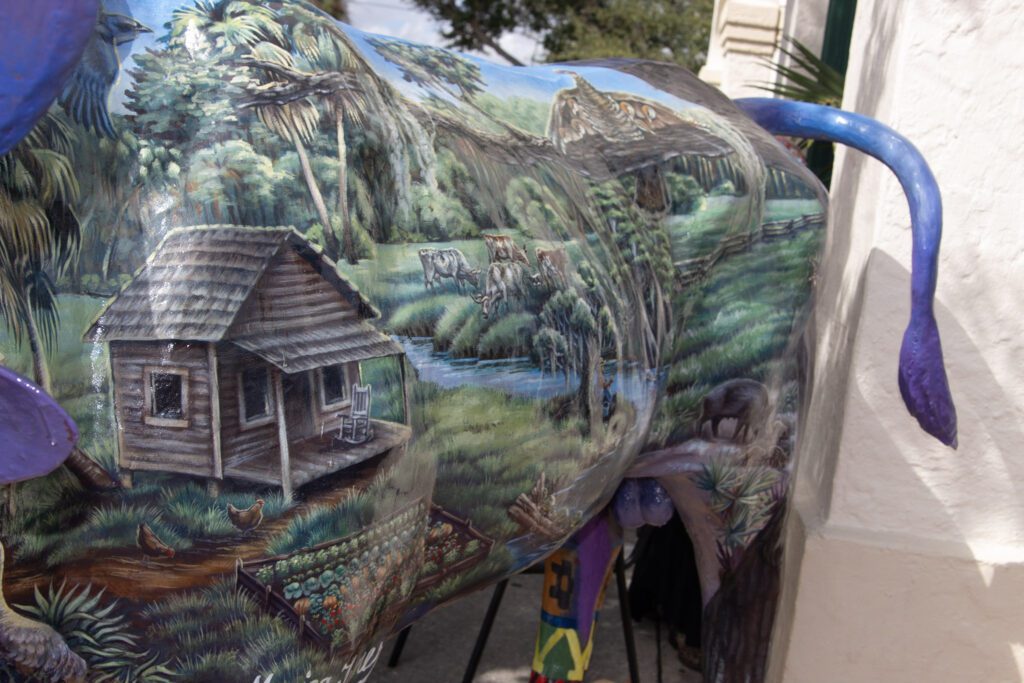Artists Paint Fiberglass Cattle in Campaign for Great Florida Cattle Drive
by MATT COBBLE
On Saturday, October 26, arts and agriculture enthusiasts in Central Florida were treated to a unique art show. The paintings were not on canvas, or hung on walls. Instead, these paintings were displayed on seven life-sized, hand-sculpted Fiberglass bulls, each hand-painted by a Floridian artist.
“I saw the call to enter to paint the bulls on Facebook in one of the cracker cowboy groups I’m in,” recalls Monica Turner of Sebring, one of the seven artists selected to participate in the show. “My art usually focuses on areas of our heritage here in rural Florida. Farming, ranching, hunting and fishing. This project was right up my alley!”
Each artist’s bull was sponsored by a different agribusiness, family, or group. Monica Turner’s sponsor was Lightsey Cattle Company of Lake Wales. The Lightsey family is part of an eight-generation ranching legacy in Florida dating to 1850.
Today, the business is run by Cary Lightsey, along with his brother Layne. With such a rich history in Florida cattle, the Lightseys agreed to a sponsorship immediately when they were approached. Cary recalled how the organizing committee “sent the sample of paintings from each artist to us first, because we were the first to send in our sponsorship check.”
Although the Lightseys did not know Monica personally, they “could tell from her paintings that she loves the history of old Florida.” The Lightseys chose two of Monica’s paintings for the bull.
“The side of the bull that features the old pioneer homestead is called ‘The Cracker Cow at Home.’ ” Monica explains. “I have tried to portray the way it might have been on a homestead with the cabin, barn and cattle. … The other side depicts a scene that might have happened as the Spanish explorers unloaded their livestock and met the Seminole Indians. They brought the original cattle to Florida, along with hogs and horses. Indian clans are represented in the mural with symbols. This side is called ‘The Patchwork of Florida’ and includes several Seminole patchwork designs.”
The unveiling event was just the first portion of a campaign by the Great Florida Cattle Drive 2021 to commemorate the 500th anniversary of Juan Ponce de León’s second and final expedition to Florida. Unlike his first mission, which was exploratory in nature, Ponce de León’s 1521 voyage was intended to colonize the land for Spain. Thus, along with soldiers, he brought priests, merchants, and farmers, who brought the first livestock (specifically, fifty horses and seven cattle), to set foot (or, in this case, set hoof) on Floridian soil. Ponce de León and his men this time landed on the West Coast of Florida, most likely near Charlotte Harbor or the Caloosahatchee River. The Calusa people repelled the colonists, mortally wounding Ponce de León in the process—but the livestock remained in Florida.
Therein lies the significance of the seven painted bulls — one for each cattle Ponce de León brought with him from Puerto Rico, considered to be among the progenitors of the modern-day Corriente breed. For the Ponce de León 1521 Herd of 7, the organizers of the Great Florida Cattle Drive made the decision to have all seven specimens be bulls to symbolize power and strength.
“The Florida Cow Culture Preservation Committee has proposed, planned, prepared, and presented a large cattle drive every 10 years since our first in 1995,” wrote Doyle Conner Jr., chairman of the committee in an invitation letter to potential participants in what is being called the Great Florida Cattle Drive. The letter describes how cracker and cow culture enthusiasts “drove 1000 head of native type cattle through about 100 miles of Florida’s most beautiful and historic ranchland.”
Michelle Turner, media relations for the Great Florida Cattle Drive, says, “The project is intended to honor the cattle industry. It’s all about promoting the cracker cowhunter way of life. Not cowboys. We are cowhunters because we have to go into the swamps and drive the cows out.”
After the initial unveiling, the Herd of 7 will be dispersed across the state, to be displayed in areas of the sponsors’ choosing for a year.
Cary Lightsey details part of the plan for their bull, “We have contacted the Seminole Tribe and asked if they would like the bull for a couple of months to display at their reservation office headquarters in Brighton, and they agreed.”
At the end of the cattle drive, four of the seven painted bulls will be auctioned off.
Of course, not every event in the Great Florida Cattle Drive will involve the painted bulls. The 2020 Reunion Ride will take place from January 31 to February 3 of 2020. The dual purposes of the Reunion Ride include reconnecting with friends both old and new, and serves for many as a time to practice the primitive camping skills that will be required on the cattle drive itself.
Then, from December 4 through December 11 of 2021 will be the week-long Great Florida Cattle Drive, which will see a herd of potentially 1,000 head of cattle (plus seven painted bulls) driven over one hundred miles through several historic Florida communities. There will be plenty of space for cattlemen (or cattlewomen) to join, but Michelle Turner gave a word of warning to potential participants: “Our informal motto for the drive is ‘It Ain’t for Sissies’ — and we mean that. We need for people to understand that this is no joke.” But for those steeped in Florida cracker culture, those words are a welcome invitation.
[ngg src=”galleries” ids=”51″ display=”basic_thumbnail” thumbnail_crop=”0″ images_per_page=”30″]

